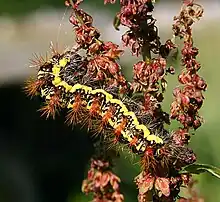| Acronicta oblinita | |
|---|---|
 | |
| Scientific classification | |
| Domain: | Eukaryota |
| Kingdom: | Animalia |
| Phylum: | Arthropoda |
| Class: | Insecta |
| Order: | Lepidoptera |
| Superfamily: | Noctuoidea |
| Family: | Noctuidae |
| Genus: | Acronicta |
| Species: | A. oblinita |
| Binomial name | |
| Acronicta oblinita (J. E. Smith, 1797) | |
| Synonyms | |
| |
Acronicta oblinita, the smeared dagger moth or arioch dagger, is a moth of the family Noctuidae. Its larva, the smartweed caterpillar, has urticating hairs.[1] The species was first described by James Edward Smith in 1797.[2][3]

Description
The smeared dagger moth adult has a wingspan of 3.6–5.4 centimetres (1.4–2.1 in).[1] The forewings have a mottled gray appearance, with orbicular and reniform spots on each dorsal surface that are incompletely outlined and indistinct.[1] Smeared-appearing dark wedge spots are present along the postmedial line with their apices pointed inward.[4] There is a terminal line of dark spots on the forewing.[1] The hindwings are white and also have small dark spots along their terminal line.[1]
The larva is a caterpillar up to 4 centimetres (1.6 in) long that bears numerous tufts of irritating setae on wart-like protuberances along its thoracic and abdominal segments.[1] There are bright yellow blotches in the shape of carets (inverted "V" shapes) between the laterally-positioned spiracles.[1][5]
Range
The smeared dagger moth is found across Canada as far north as Lake Athabasca.[6] In the United States, the moth is found in the Pacific Northwest[4] and east of the Rocky Mountains south to Florida and Texas.[6][7]
Habitat
Habitats include bogs and coastal marshes in the Pacific Northwest[4] and wetlands, forests and meadows more generally.[6] Individuals have been collected in boreal forests in Canada.[6]
Life cycle

The smeared dagger moth has one to two generations per year.[1][8] In the coastal plain of North Carolina, adults can be seen beginning in early March through late June and again from mid-August until early October.[8] Caterpillars may pupate within folded leaves of their host plant.[9] Overwintering occurs as pupae.[1]
Host plants
Larval hosts:
References
- 1 2 3 4 5 6 7 8 9 Valo, John, ed. (2022). "smeared dagger (Actonicta oblinita)". MinnesotaSeasons.com. Retrieved 15 September 2022.
- ↑ Beccaloni, G.; Scoble, M.; Kitching, I.; Simonsen, T.; Robinson, G.; Pitkin, B.; Hine, A.; Lyal, C., eds. (2003). "Acronicta oblinita". The Global Lepidoptera Names Index. Natural History Museum. Retrieved 15 September 2022.
- ↑ Savela, Markku (August 29, 2020). "Acronicta oblinita (Smith, 1797)". Lepidoptera and Some Other Life Forms. Retrieved 15 September 2022.
- 1 2 3 4 "Acronicta oblinita (J.E. Smith, 1797)". Pacific Northwest Moths. Retrieved 15 September 2022.
- ↑ Cotinis (9 August 2020). "Species Acronicta oblinita - Smeared Dagger - Hodges#9272". BugGuide. Retrieved 15 September 2022.
- 1 2 3 4 5 6 7 8 9 Anweiler, G.G. (7 April 2003). "Acronicta oblinita". University of Alberta Museums. Retrieved 15 September 2022.
- ↑ "931485.00 – 9272 – Acronicta oblinita". North American Moth Photographers Group at the Mississippi Entomological Museum at the Mississippi State University. Retrieved 15 September 2022.
- 1 2 Hall, S.P.; Sullivan, J.B.; Petranka, J.W.; Backstrom, P.; Howard, T. (2022). "Acronicta oblinita (J.E. Smith, 1797) - Smeared Dagger". The Moths of North Carolina. Raleigh: North Carolina Biodiversity Project and North Carolina State Parks. Retrieved 21 September 2022.
- 1 2 Childs, Ken. O'Connor, Marcie (ed.). "Acronicta oblinita - Smeared Dagger Moth". Bug Life Cycles. Retrieved 21 September 2022.
External links
- Anweiler, G. G. & Schmidt, B. C. (April 7, 2003). "Species Details Acronicta oblinita". University of Alberta Museums. E.H. Strickland Entomological Museum. Retrieved November 10, 2020.
 Media related to Acronicta oblinita at Wikimedia Commons
Media related to Acronicta oblinita at Wikimedia Commons